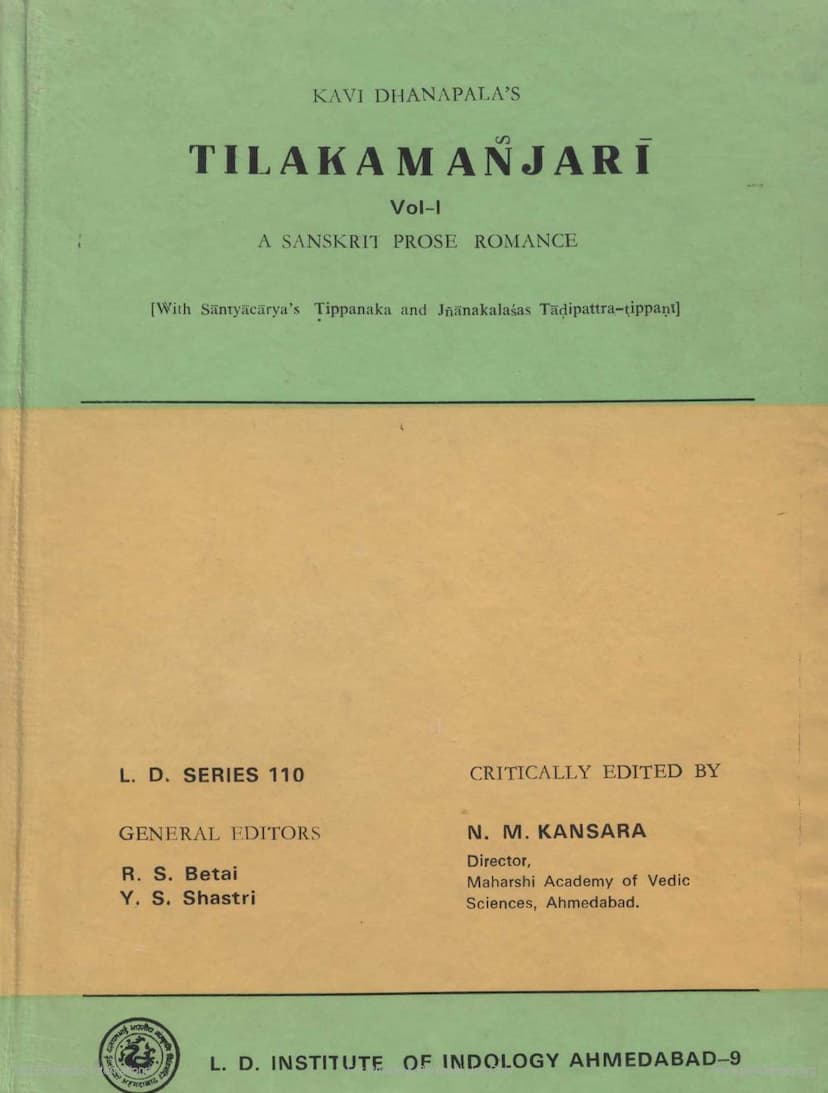Tilakmanjari
Added to library: September 2, 2025

Summary
This document provides a comprehensive summary of the Jain text "Tilakamanjari" by Dhanpal Mahakavi, published by L.D. Indology, Ahmedabad. The provided text includes the title page, copyright notice, editorial page, preface, introduction, and a significant portion of the Sanskrit text with commentaries and critical apparatus.
Here's a breakdown of the key information:
Book Details:
- Title: Tilakamanjari
- Author: Dhanapala Mahakavi
- Publisher: L. D. Institute of Indology, Ahmedabad
- Volume: Vol-1
- Nature: A Sanskrit Prose Romance (gadya-kāvya)
- Commentaries Included:
- Santyaacharya's Tippanaka
- Jnanakalasas Tādipattra-tippani (Tadapatriya-prānta-tippani)
- Series: L. D. Series 110
- Critical Editor: Dr. N. M. Kansara
- General Editors: R. S. Betai, Y. S. Shastri
- First Edition: June 1991
- Price: Rs. 220/-
Content of the Document:
The document is a critical edition of the "Tilakamanjari." It begins with the publication details and progresses through:
- Editorial Note: Expressing pleasure in presenting the work to enlightened readers and mentioning that Part I is based on the author's Ph.D. thesis.
- Preface: Dr. N. M. Kansara details the significance of "Tilakamanjari" (composed between 1015-1055 AD in Dhara), its reflection of the contemporary socio-political and cultural landscape of the Paramara Empire, and the extensive research undertaken for its critical edition. He highlights the importance of manuscripts and the challenges faced in their collection and collation, including the critical role played by various scholars and institutions. He also narrates the arduous journey of preparing the press copy and the unfortunate loss of some material, requiring a dedicated effort to complete the work.
- Introduction: This section delves into the scholarly aspects of the work:
- Previous Editions: Discusses earlier published versions of "Tilakamanjari," noting their shortcomings and the need for a critical edition based on manuscripts.
- Textual Lacunae: Identifies specific passages missing in certain editions (TM(N)) and compares them with other manuscript traditions.
- Textual Corruptions and Their Sources: Analyzes the causes of textual errors in different editions, attributing them to the misinterpretation of marginal notes or lack of editorial precision.
- Critical Apparatus: Lists and describes various manuscripts of "Tilakamanjari" consulted for the critical edition. This includes detailed information about the material, date, condition, script, and provenance of several key manuscripts (Jesalmer Ms., Punyavijayaji Ms., Sanghavipada Bhandara Ms., Vadipārshvanātha Bhandara Ms., Shantisagar Upashray Bhandara Ms., Bhandarkar Institute Ms., Ujambai Upashray Bhandar Ms., Kantivijayaji Bhandara Ms., and subsequent copies).
- Commentaries on the TM: Provides information about four known commentaries on "Tilakamanjari," including their authors, historical context, content, and publication status. These are:
- "Tilakamanjari-tippanaka" by Santisuri.
- "Tadapatriya-pranta-tippani" (Marginal notes in P. Ms.).
- "Tilakamanjari-vritti" by Pannyasa Padmasagara.
- "Paraga-vivrti" by Shri Vijayalavanyasuri.
- Compendiums of the TM: Mentions at least four compendiums derived from "Tilakamanjari," including a Gujarati novel adaptation.
- Sanskrit Text: The bulk of the document consists of the critically edited Sanskrit text of "Tilakamanjari," interspersed with the Sanskrit commentary (Tippanaka and Tādipattra-tippani).
- Appendices:
- Appendix A: Index of Verses.
- Appendix B: Index of Metres.
- Appendix C: Index of Subhashitas (wise sayings).
- Appendix D: Index of Idiomatic and Colloquial Usages.
- Appendix E: Index Verborum (a word index).
- Appendix F: Variant Readings, detailing discrepancies found in different manuscripts.
Significance of the Work:
The "Tilakamanjari" is presented as a classical Sanskrit prose romance that, while set in a Jain socio-religious context, offers valuable insights into the contemporary social, political, literary, and cultural trends of the Paramara Empire of Malwa. The critical edition aims to provide an authentic text that serves as a solid foundation for serious academic study of the work, filling a significant lacuna in Sanskrit scholarship.
In essence, this document is a scholarly endeavor to present a critically edited version of a significant Jain literary work, making it accessible to researchers and readers with detailed textual analysis, manuscript information, and extensive commentary.